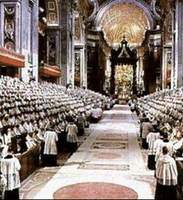Friday, August 11, 2006
Lumen Gentium 1

The Dogmatic Constitution on the Church was issued in November 1964 during the third session of the Second Vatican Council. The Latin title of this document (and most Vatican documents) is taken from the first words, "Light" and "of nations, peoples, clans." The Latin gens has a wider meaning than simply "nations." If that's of any relevance it only means that the English translation of "nations" is perhaps narrower than the intent.
As we delve into one of the seminal efforts of Vatican II, permit me to review the format for any interested observer or commentator. If St Blog's is a parish, this very much like adult education in most places: much lower attendance than coffee and donuts, the children's Christmas program, or the parish dinner dance. Unlike many DRE's, that doesn't bother me too much.
The effort here is very basic. We take the Vatican II document section by numbered section, about one a day. I excerpt it in whole from the Vatican web site's English translation. I edit that translation for inclusive language (the Latin homo becomes "people," not "man," for example). I incorporate the footnotes into the text. I make a thoughtful comment or two, and lacking that, maybe a pithy one. Other people are free to comment as they please.
We make daily progress through the texts that changed the Church, and hopefully some are edified. I know that I've benefitted from a slow and careful reading of Vatican II documents. Brigid keeps urging me to upgrade the site and start stuff like organized archives, topic tagging, and the like. And I'll get around to it. Soon hopefully.
So enough yammering already. Let's dive in to the beginning of Chapter 1, entitled "The Mystery of the Church."
Christ is the Light of nations. Because this is so, this Sacred Synod gathered together in the Holy Spirit eagerly desires, by proclaiming the Gospel to every creature, (cf Mk. 16, 15) to bring the light of Christ to all (people), a light brightly visible on the countenance of the Church. Since the Church is in Christ like a sacrament or as a sign and instrument both of a very closely knit union with God and of the unity of the whole human race, it desires now to unfold more fully to the faithful of the Church and to the whole world its own inner nature and universal mission. This it intends to do following faithfully the teaching of previous councils. The present- day conditions of the world add greater urgency to this work of the Church so that all (people), joined more closely today by various social, technical and cultural ties, might also attain fuller unity in Christ.
This tells us a lot. We have a reiteration of the twofold purpose of the Church and Council: to proclaim the message of Christ, and to bring the light of Christ everywhere. Note that evangelization does not always include explicit preaching.
The council bishops begin a definition of the Church:
- We are sacramental
- We signify a union with God
- At the same time, we serve as a tool to unite believers intimately with God
- On another level, we are devoted to human unity, even among non-believers
Then the purpose of Lumen Gentium is described. It is written for both Church and the world. It intends to edify each group with a tradition-oriented description of nature and mission.
Lastly, the council bishops recognize the world situation of the 1960's was a motivating factor for them. Various cultural forces binding people more closely on the Earth are an opportunity for a human unity in Jesus Christ.
If a person, parish, or any group of believers can align with these priorities, can we safely say they are "Vatican II Catholics?" Do you fit with this description? What about the people you know? Have you any other comments?